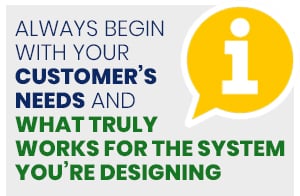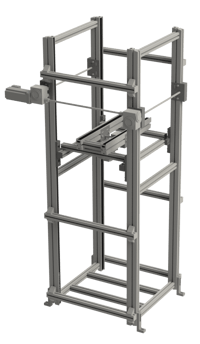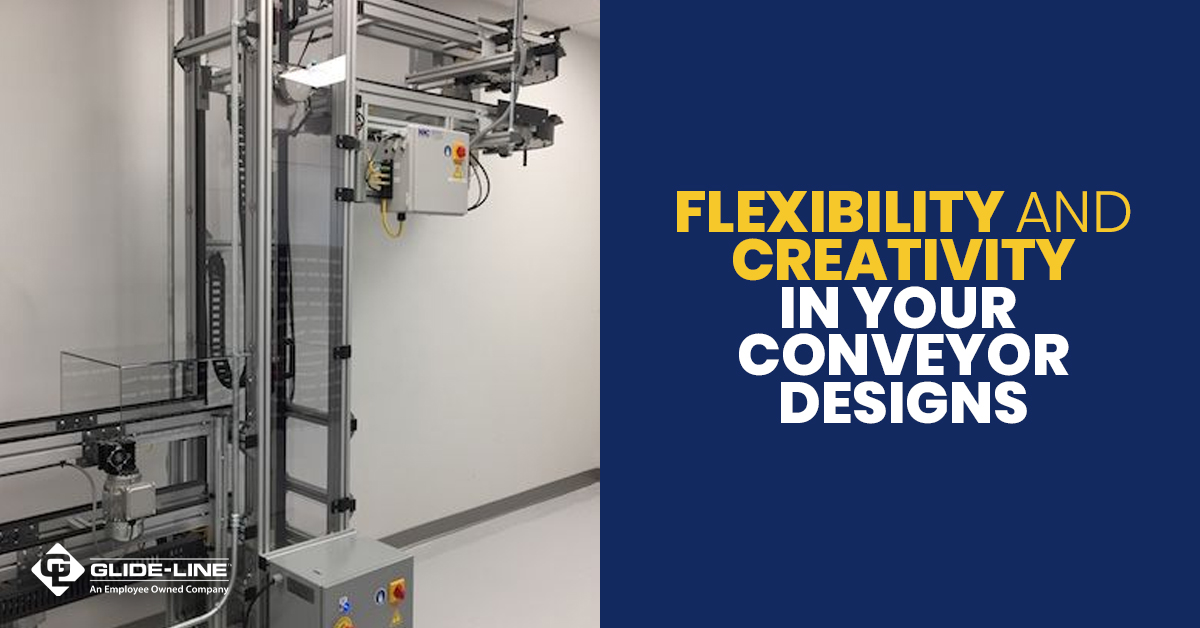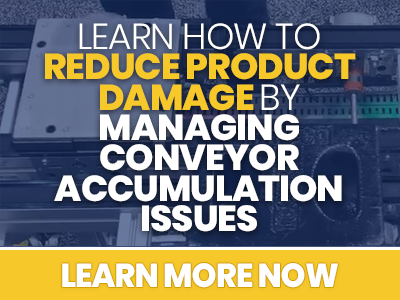Creative, custom and configurable conveyor systems are what we do best. When we found ourselves dissatisfied with the market’s current offerings – inflexible designs, as well as long lead times, poor customer service, and rising (and unnecessary) costs – we decided we could do it better. Following our own advice, we set out to create a product and supporting tools that would satisfy customer needs in ways no one else could.
We vowed to change the status quo - allow for flexibility and creativity in conveyor designs. That is why we created our Interactive Modeling Program and Application Configuration Tool, IMPACT! and why we strive to be consistently nimble, the future of flexible conveyor system manufacturing.
So, let's get creative! Here are our top 5 tips for allowing those creative juices to flow.
 START WITH WHAT WORKS FOR CUSTOMER, YOUR SYSTEM, AND YOUR DESIGN
START WITH WHAT WORKS FOR CUSTOMER, YOUR SYSTEM, AND YOUR DESIGN
 This is the most pertinent tip we can give you: always begin with your customer’s needs and what truly works for the system you’re designing. When you aren’t locked into a specific set of conveyor options, you’re able to offer flexibility in your engineered designs of what a conveyor system is able to accomplish.
This is the most pertinent tip we can give you: always begin with your customer’s needs and what truly works for the system you’re designing. When you aren’t locked into a specific set of conveyor options, you’re able to offer flexibility in your engineered designs of what a conveyor system is able to accomplish.
Find a supplier who is already offering innovative solutions. For example, Glide-Line’s 360 is a combination of powered timing belt based conveyors working together to meet almost any type of orientation change, sort, or shift for your customer’s product in any space (even compact ones). This system allows for endless configurations and maximizes assembly workspace, including moving conveyors on a 45-degree angle. These types of innovation are available as a standard, not as a premium, which doesn’t limit your creativity.
 THINK VERTICALLY
THINK VERTICALLY
When it comes to conveyors, so often we think only horizontally of products moving from A to B to C. This setup can use up much of the space the customer has to work with for their automation system design.
Instead, think vertically to creatively use the space, sending product from A to C and back to A, then to B. The more efficiently you use the space, the more money and product the customer can make in the space they have, and the more conveyor systems (or other automation) you’re able to provide them with.
 USE VERTICAL TRANSPORT UNITS DIFFERENTLY
USE VERTICAL TRANSPORT UNITS DIFFERENTLY
 Using a better-designed vertical transport unit (VTU), engineers are able to use VTUs in a more innovative way. While the typical way of designing this unit is to put a pneumatic rodless cylinder on one side of the moving deck and then cantilever the deck out in one of two places, updated and newly designed VTUs solve challenges differently by:
Using a better-designed vertical transport unit (VTU), engineers are able to use VTUs in a more innovative way. While the typical way of designing this unit is to put a pneumatic rodless cylinder on one side of the moving deck and then cantilever the deck out in one of two places, updated and newly designed VTUs solve challenges differently by:
- Supporting the VTU deck on all 4 sides, resulting in a significantly more robust mechanical design vs. a cantilever design
- Using an electric servo to control the positioning, which is smoother, faster, and more controlled
- Using the servo to stop the conveyor deck more precisely and at multiple positions for sorting and/or other multi-positioning requirements
 ADAPT TO EXISTING PARTS, WHEREVER POSSIBLE
ADAPT TO EXISTING PARTS, WHEREVER POSSIBLE
Reusing the customer’s current equipment in a new, advanced conveyor system can save the customer resources. However, utilizing existing equipment doesn’t have to hinder innovations in the design of a modular conveyor.
For example, Glide-Line can easily be adapted to the standards required for the plant where the automation will take place. We do this with modular and/or customized gearbox flanges to your specification. This brings us to our next point.
 REDUCE THE CUSTOMER’S COSTS DURING YOUR ENGINEERING DESIGN PHASE
REDUCE THE CUSTOMER’S COSTS DURING YOUR ENGINEERING DESIGN PHASE
The return on your customer’s investment with you hinges on your ability to efficiently create an automation system that meets their needs and, at the end of the day, makes them money. Maximizing their ROI involves using innovations in your systems, reducing their delivery and installation times, and reducing the maintenance needed long-term for the system put in place.
When you’re designing automated conveyor systems, there are a number of ways to focus on reducing costs to your customer:
%20(1).png?width=296&name=Direct%20product%20handling%20zero%20pressure%20(appliance%20project)%20(1).png) Reduce maintenance costs by reducing backpressure caused by accumulation using an indexing conveyor style instead of traditional conveyors. Instead of causing unnecessary wear and tear on the entire system by continuously running the conveyors, this style only runs when product approaches and has a permissive from downstream, maintaining distance between products to eliminate backpressure.
Reduce maintenance costs by reducing backpressure caused by accumulation using an indexing conveyor style instead of traditional conveyors. Instead of causing unnecessary wear and tear on the entire system by continuously running the conveyors, this style only runs when product approaches and has a permissive from downstream, maintaining distance between products to eliminate backpressure.- Reduce product damage and violent acceleration / deceleration forces by taking a more elegant approach to backing product up. This design reduces wear and tear on conveyors, pallets, and is much gentler to your product being conveyed. Products or pallets always retain a gap and never touch each other, but you still maintain an asynchronous overall design concept.
Simply, accurate and impressive delivery of any conveyor system shouldn’t be hindered by software or lack of innovation in configurations. Focus on finding a manufacturer who enables you to do the best work you can, providing flexibility, innovation, and speed in your own process.
Check out IMPACT! now or read more about creating flexible designs in our free guide...







Leave a Comment